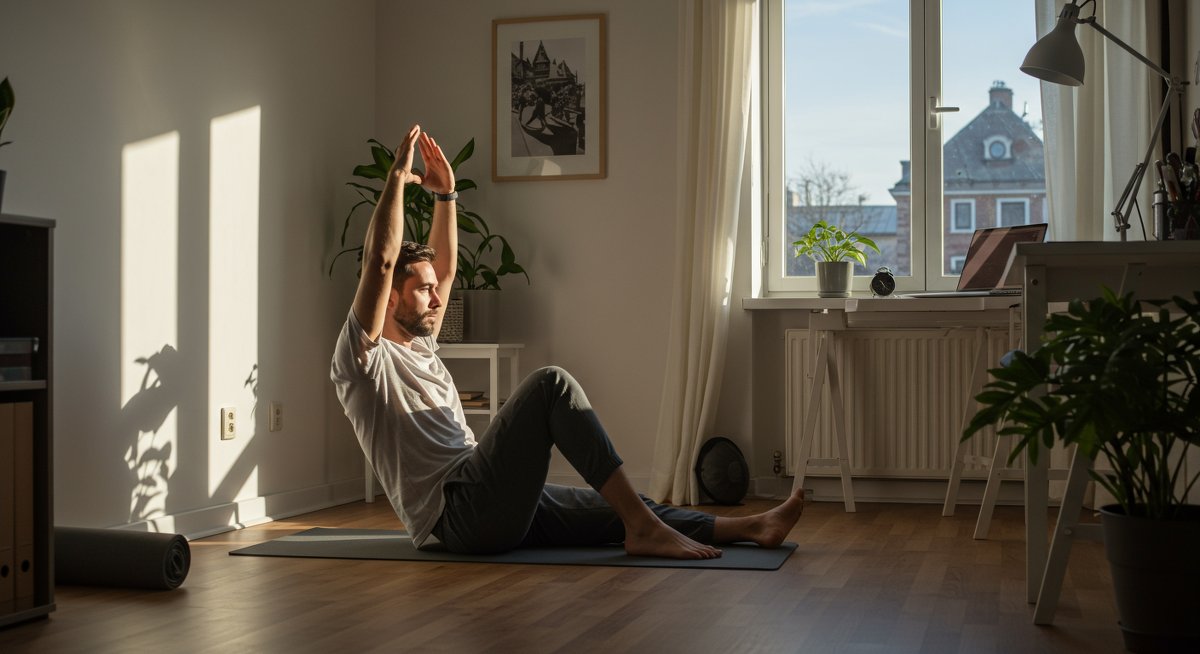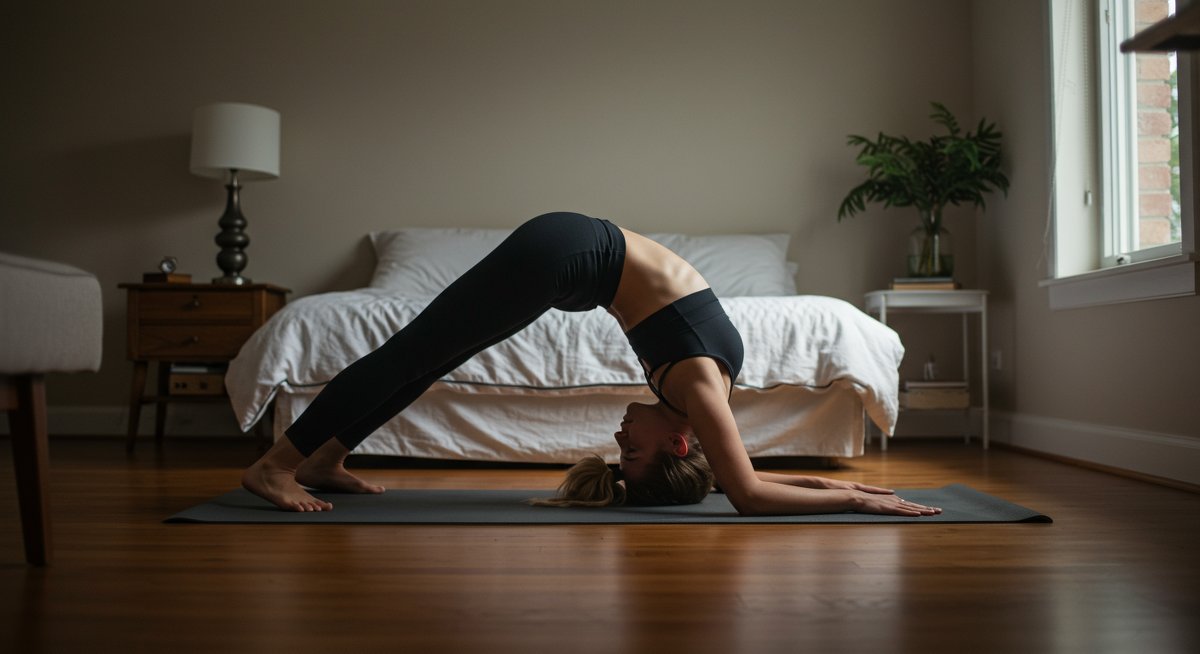Sitting at a desk for extended periods can take a toll on your body, leading to poor posture, back pain, and decreased energy levels. But there's a simple solution: yoga! This guide offers five essential yoga poses specifically designed to counteract the negative effects of a desk job. These poses are easy to do at home or in the office, requiring no equipment and just a few minutes of your time. Ready to reclaim your well-being? Let's dive in!

The Benefits of Yoga for Desk Workers
Before we get into the poses, let's explore why yoga is the perfect antidote to a desk job. Regular yoga practice can significantly improve your physical and mental health. For desk workers, it offers several key benefits:
- Improved Posture: Yoga strengthens the muscles that support proper alignment, counteracting the slouching that often accompanies long hours at a desk.
- Reduced Pain: Yoga can alleviate back, neck, and shoulder pain caused by repetitive strain and poor posture.
- Increased Energy: Yoga boosts circulation and oxygen flow, combating fatigue and increasing alertness.
- Stress Relief: Yoga's focus on breath and mindfulness helps to reduce stress and promote a sense of calm.
- Enhanced Flexibility: Yoga improves flexibility, making it easier to move and reducing the risk of injury.
Here's an example: Sarah, a marketing manager, started experiencing severe back pain after working from home during the pandemic. She began incorporating a 10-minute yoga routine into her workday, using the poses described below. Within a few weeks, her back pain decreased significantly, and she felt more energetic and focused throughout the day.
Another example: John, a software engineer, noticed his shoulders were constantly tense. He started practicing these yoga poses during his lunch break. By focusing on his breath and stretching his muscles, he noticed a significant reduction in tension and stress, leading to a better work-life balance. Many people also find that using yoga to manage stress helps them sleep better.
Essential Poses for Desk Workers
These five yoga poses are specifically chosen to target the areas most affected by prolonged sitting. Each pose includes step-by-step instructions, along with modifications and tips to ensure you get the most out of your practice.
1. Seated Mountain Pose (Tadasana in Chair)
- Benefits: Improves posture, lengthens the spine, and promotes a sense of grounding.
- Instructions:
- Sit upright in your chair with your feet flat on the floor, hip-width apart.
- Lengthen your spine, imagining a string pulling you up from the crown of your head.
- Relax your shoulders, drawing them down and away from your ears.
- Gently engage your core muscles.
- Close your eyes, or focus on a point in front of you, and breathe deeply for 5-10 breaths.
- Modifications: If you have trouble sitting upright, place a cushion behind your lower back for support. If you cannot reach your feet flat on the floor, put a block or book underneath.
- Expert Tip: Visualize your spine lengthening with each inhale. This mental focus can help you maintain proper posture.
2. Seated Cat-Cow Stretch
- Benefits: Improves spinal mobility, stretches the back and abdomen, and relieves tension.
- Instructions:
- Sit upright in your chair with your feet flat on the floor.
- Place your hands on your knees.
- Cow Pose: Inhale, arch your back, drop your belly, and lift your chest. Look up slightly.
- Cat Pose: Exhale, round your spine, tuck your chin to your chest, and pull your belly button towards your spine.
- Alternate between Cow and Cat poses for 5-10 rounds, coordinating your breath with your movements.
- Modifications: If you have limited mobility, focus on the spinal movement and avoid extreme arching or rounding.
- Expert Tip: Focus on feeling each vertebra move during the transition between poses. This awareness can help prevent injuries.
3. Seated Spinal Twist
- Benefits: Improves spinal flexibility, massages internal organs, and relieves stress.
- Instructions:
- Sit upright in your chair with your feet flat on the floor.
- Place your right hand on your left knee and your left hand on the back of the chair.
- Inhale to lengthen your spine.
- Exhale, gently twist your torso to the left, looking over your left shoulder.
- Hold for 5-10 breaths.
- Repeat on the other side.
- Modifications: If you have shoulder issues, avoid twisting too deeply. Instead, gently support your shoulder with your opposite hand.
- Expert Tip: Keep your spine straight throughout the twist, avoiding any rounding or hunching.
4. Seated Forward Fold
- Benefits: Stretches the spine, hamstrings, and shoulders, and calms the mind.
- Instructions:
- Sit upright in your chair with your feet flat on the floor.
- Inhale, raise your arms overhead.
- Exhale, bend forward from your hips, keeping your spine as straight as possible.
- Reach for your toes or let your hands rest on the floor. If you can't reach, rest them on your shins or thighs.
- Let your head hang heavy.
- Hold for 5-10 breaths.
- Inhale, slowly roll back up to a seated position.
- Modifications: If you have tight hamstrings, bend your knees slightly. If you feel pain, don't go as far forward.
- Expert Tip: Focus on releasing tension in your neck and shoulders. You can add deep breathing exercises.
5. Seated Shoulder Opener
- Benefits: Relieves shoulder and chest tension, improves posture.
- Instructions:
- Sit upright in your chair with your feet flat on the floor.
- Interlace your fingers behind your back, palms together, or hold a towel between your hands.
- Draw your shoulders back and down.
- Gently lift your interlaced hands away from your back, opening your chest.
- Hold for 5-10 breaths.
- Release and repeat as needed.
- Modifications: If interlacing your fingers is difficult, use a towel or strap to assist. Avoid forcing the stretch.
- Expert Tip: Focus on breathing deeply into your chest, expanding your ribcage to deepen the stretch.
Tips for Success
Incorporating these yoga poses into your daily routine is easy. Here are some practical tips to help you succeed:
- Consistency is Key: Aim for at least 10-15 minutes of yoga each day, even if it's just during your lunch break. Regular practice yields the best results.
- Create a Schedule: Set a specific time each day for your yoga practice. Consistency helps you make it a habit.
- Listen to Your Body: Don't push yourself too hard, especially when you're starting. Modify poses as needed and avoid any movements that cause pain.
- Breathe Deeply: Focus on your breath throughout each pose. Deep, conscious breathing enhances the benefits of the stretches and promotes relaxation.
- Find a Comfortable Space: Designate a quiet area where you can practice without distractions. Even a small space in your office will work.
Benefits and How it Helps Your Goals
The benefits of incorporating yoga into your daily routine extend far beyond just alleviating the physical discomfort of a desk job. Yoga is a holistic practice that promotes overall well-being, helping you achieve multiple goals at once.
- Improved Physical Health: Reduced back pain, improved posture, and increased flexibility contribute to a healthier body and reduced risk of injury.
- Stress Reduction: The focus on breath and mindfulness helps to calm your mind and reduce stress levels, promoting better mental health.
- Increased Energy: Enhanced circulation and oxygen flow boost energy levels, helping you stay alert and productive throughout the day.
- Better Focus and Concentration: Yoga can improve your cognitive function, making it easier to concentrate on work tasks.
- Enhanced Work-Life Balance: Taking regular breaks for yoga promotes better self-care, which can improve your overall well-being and balance in your life.
Here is a case study: Mark, a project manager, was always stressed at work, which led to back pain and headaches. He started practicing the poses regularly, and within a month, he was not only feeling better physically but also experienced less anxiety. He also noticed an increase in productivity and better relationships with his colleagues.

How to Fit It Into Your Busy Schedule
One of the best things about these yoga poses is their flexibility and ease of integration into your daily routine. Here are some practical ways to fit them into your busy schedule:
- Morning Routine: Start your day with a few rounds of seated cat-cow and a seated spinal twist to energize your body and prepare your mind for the day.
- During Work Breaks: Set a timer for every hour and take a 2-3 minute break to do a few poses. The seated forward fold and shoulder opener are great options.
- Lunch Break: Dedicate your lunch break to a longer yoga session. Follow the full sequence of poses and enjoy the benefits of a more extended practice.
- End-of-Day Routine: Before you leave the office, do a few poses to release tension and unwind. The seated twist and forward fold are excellent choices to leave the stress behind.
- Weekend Practice: Incorporate these poses into your weekend routine. Combine them with other activities like walking in nature or other light exercises.
Here's a quick example: If you only have 10 minutes, do 2 minutes of seated mountain pose, 2 minutes of seated cat-cow, 2 minutes of seated spinal twist on each side, and finish with 2 minutes of seated shoulder opener. The result will be a quick, simple, and accessible yoga experience to benefit the body.
Quick Warm-up and Cool-down
Before you begin your yoga poses, a quick warm-up can prepare your body and enhance the benefits. After your poses, a cool-down can help you relax and integrate the practice.
Warm-up (2 minutes)
- Gentle Neck Rolls: Slowly rotate your head from side to side, and then up and down.
- Shoulder Circles: Roll your shoulders forward and backward, several times.
- Wrist Rolls: Rotate your wrists in both directions.
Cool-down (2 minutes)
- Deep Breathing: Sit comfortably and focus on your breath. Inhale deeply through your nose and exhale slowly through your mouth.
- Gentle Stretching: Hold each stretch for 15-30 seconds to deepen your relaxation.
Next Steps in Your Home Fitness Journey
Now that you've learned these essential yoga poses, here's how to continue your journey:
- Explore More Poses: Expand your knowledge by learning additional yoga poses that target different parts of the body.
- Find a Yoga App: Consider using a yoga app like the Nike Training Club App to access guided classes and track your progress.
- Join Online Classes: Look for online yoga classes to connect with instructors and other practitioners.
- Create a Yoga Space: Designate a space in your home or office for your yoga practice to help build consistency.
- Track Your Progress: Note how you feel before and after each yoga session to monitor your progress.
By incorporating yoga into your daily routine, you can effectively combat the negative effects of a desk job and improve your overall health and well-being. Start today, and experience the transformative power of yoga!